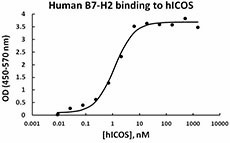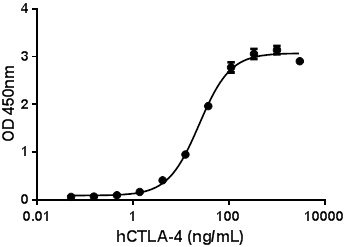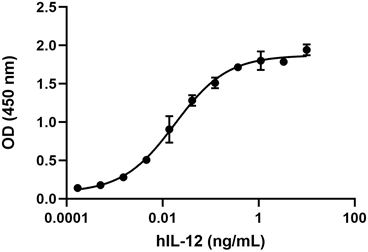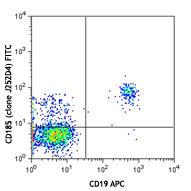- Regulatory Status
- RUO
- Other Names
- B7 homolog 2 (B7H2), GL50, B7 related protein 1 (B7RP1), CD275, inducible T cell costimulator ligand ICOS Ligand), LICOS, ICOSLG
- Ave. Rating
- Submit a Review
- Product Citations
- publications

-

Recombinant human B7-H2-Fc Chimera is able to bind recombinant human ICOS protein in a dose dependent manner. The kD value of this binding is <5.0 nM.
B7-H2 belongs to the B7 family of immunoregulatory molecules and is a transmembrane glycoprotein of approximately 60 kD. Mature human B7-H2 consists of a 238 amino acid extracellular domain (ECD), two immunoglobulin-like domains, a 21 amino acid transmembrane segment, and a 25 residue cytoplasmic domain. Within the ECD, human B7-H2 shares 50% and 54% amino acid sequence identity with mouse and rat B7-H2, respectively. B7-H2 is expressed on antigen presenting cells such as B cells, macrophages, dendritic cells, and also in monocytes. It binds to ICOS and is expressed on activated T cells, which leads to both positive and negative effects on immune responses including its own downregulation. Mouse and human B7-H2 exhibit cross species binding to ICOS. B7-H2 interaction with ICOS is costimulatory for T cell proliferation as well as the development of B cells, plasma cells, follicular helper T cells, and germinal centers. In addition, human B7-H2 binds to CD28 and CTLA4. The interaction of human B7-H2 and CD28 can costimulate both human mouse naïve T cells and regulatory T cells (Treg). B7-H2 plays a role in the development of allergic asthma by enhancing Th2 biased immune responses, limiting Th17 responses, and promoting eosinophilic infiltration into the lungs. B7-H2 activation of ICOS on Tregs limits pulmonary inflammation and airway hyper-responsiveness, promotes the development of inhalational tolerance, and impairs anti-tumor immunity.
Product DetailsProduct Details
- Source
- Human B7-H2, amino acids (Asp19-Ser258) (Accession# NP_001269979.1), was expressed in 293E cells with a human IgG1 Fc tag at the C-terminus.
- Molecular Mass
- This 478 amino acid recombinant protein with a C-terminal human IgG1 Fc tag has a predicted molecular mass of approximately 54 kD. The protein migrates as above 55 kD in SDS-PAGE in DTT-reducing condition and above 110 kD in non-reducing condition. The predicted N-terminal amino acid is Asp.
- Purity
- >95%, as determined by Coomassie stained SDS-PAGE.
- Formulation
- 0.22 µm filtered protein solution is in PBS.
- Endotoxin Level
- Less than 0.1 EU per µg of protein as determine by the LAL method
- Concentration
- 10 and 25 µg sizes are bottled at 200 µg/mL. 100 µg size and larger sizes are lot-specific and bottled at the concentration indicated on the vial. To obtain lot-specific concentration and expiration, please enter the lot number in our Certificate of Analysis online tool.
- Storage & Handling
- Unopened vial can be stored between 2°C and 8°C for up to 2 weeks, at -20°C for up to six months, or at -70°C or colder until the expiration date. For maximum results, quick spin vial prior to opening. The protein can be aliquoted and stored at -20°C or colder. Stock solutions can also be prepared at 50 - 100 µg/mL in appropriate sterile buffer, carrier protein such as 0.2 - 1% BSA or HSA can be added when preparing the stock solution. Aliquots can be stored between 2°C and 8°C for up to one week and stored at -20°C or colder for up to 3 months. Avoid repeated freeze/thaw cycles.
- Activity
- Immobilized human B7-H2-Fc Chimera at 1 µg/mL (100 µL/well) can bind recombinant human ICOS-Fc in a dose dependent manner with a kD < 5.0 nM.
- Application
-
Bioassay
- Application Notes
-
BioLegend carrier-free recombinant proteins provided in liquid format are shipped on blue-ice. Our comparison testing data indicates that when handled and stored as recommended, the liquid format has equal or better stability and shelf-life compared to commercially available lyophilized proteins after reconstitution. Our liquid proteins are verified in-house to maintain activity after shipping on blue ice and are backed by our 100% satisfaction guarantee. If you have any concerns, contact us at tech@biolegend.com.
Antigen Details
- Structure
- Homodimer
- Distribution
-
B cells, macrophages, monocytes, and dendritic cells.
- Function
- The B7-H2/ICOS signal induces T cell proliferation and secretion of both Th1 and Th2 cytokines, such as IL-4 and IFN-γ, but not IL-2 ( it also induces IL-5 and TNF-α production). B7-H2/ICOS signal may favor the induction of Th2-type responses and thus may be involved in the negative regulation of cell-mediated immune responses against tumors. B7-H2 is induced by TNF-α in B cells and monocytes and downregulated in dendritic cells.
- Interaction
- Activated T cells.
- Ligand/Receptor
- ICOS
- Bioactivity
- Human B7-H2 is able to bind human ICOS.
- Cell Type
- Dendritic cells, Tregs
- Biology Area
- Cell Adhesion, Cell Biology, Costimulatory Molecules, Immunology, Signal Transduction
- Molecular Family
- Soluble Receptors, TCRs
- Antigen References
-
1. Ishikawa K, et al. 1998. DNA Res. 5:169.
2. Yoshinaga SK, et al. 2000. Int. Immunol. 12:1439.
3. Flesch IE, 2003. J. Biol. Regul. Homeost. Agents 16:217.
4. Akbari O, et al. 2002. Nat. Med. 8:1024.
5. Yao S, et al. 2011. Immunity 34:729. - Gene ID
- 23308 View all products for this Gene ID
- UniProt
- View information about B7-H2 on UniProt.org
Related FAQs
- Why choose BioLegend recombinant proteins?
-
• Each lot of product is quality-tested for bioactivity as indicated on the data sheet.
• Greater than 95% Purity or higher, tested on every lot of product.
• 100% Satisfaction Guarantee for quality performance, stability, and consistency.
• Ready-to-use liquid format saves time and reduces challenges associated with reconstitution.
• Bulk and customization available. Contact us.
• Learn more about our Recombinant Proteins. - How does the activity of your recombinant proteins compare to competitors?
-
We quality control each and every lot of recombinant protein. Not only do we check its bioactivity, but we also compare it against other commercially available recombinant proteins. We make sure each recombinant protein’s activity is at least as good as or better than the competition’s. In order to provide you with the best possible product, we ensure that our testing process is rigorous and thorough. If you’re curious and eager to make the switch to BioLegend recombinants, contact your sales representative today!
- What is the specific activity or ED50 of my recombinant protein?
-
The specific activity range of the protein is indicated on the product datasheets. Because the exact activity values on a per unit basis can largely fluctuate depending on a number of factors, including the nature of the assay, cell density, age of cells/passage number, culture media used, and end user technique, the specific activity is best defined as a range and we guarantee the specific activity of all our lots will be within the range indicated on the datasheet. Please note this only applies to recombinants labeled for use in bioassays. ELISA standard recombinant proteins are not recommended for bioassay usage as they are not tested for these applications.
- Have your recombinants been tested for stability?
-
Our testing shows that the recombinant proteins are able to withstand room temperature for a week without losing activity. In addition the recombinant proteins were also found to withstand four cycles of freeze and thaw without losing activity.
- Does specific activity of a recombinant protein vary between lots?
-
Specific activity will vary for each lot and for the type of experiment that is done to validate it, but all passed lots will have activity within the established ED50 range for the product and we guarantee that our products will have lot-to-lot consistency. Please conduct an experiment-specific validation to find the optimal ED50 for your system.
- How do you convert activity as an ED50 in ng/ml to a specific activity in Units/mg?
-
Use formula Specific activity (Units/mg) = 10^6/ ED50 (ng/mL)
 Login / Register
Login / Register 














Follow Us